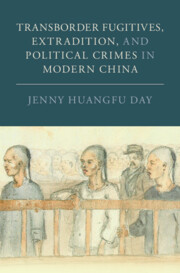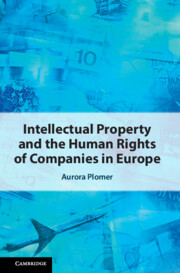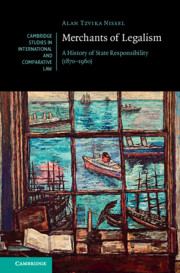Refine search
Actions for selected content:
243 results
2 - Broken Contracts
-
- Book:
- Debts Unpaid
- Published online:
- 04 November 2025
- Print publication:
- 20 November 2025, pp 53-98
-
- Chapter
- Export citation

Transborder Fugitives, Extradition, and Political Crimes in Modern China
-
- Published online:
- 10 November 2025
- Print publication:
- 30 October 2025
2 - Wardship and the Feudal Incidents, 1066–1540
-
- Book:
- Institutional Change and Property Rights before the Industrial Revolution
- Published online:
- 23 October 2025
- Print publication:
- 06 November 2025, pp 23-42
-
- Chapter
- Export citation
6 - Law and the Court of Wards
-
- Book:
- Institutional Change and Property Rights before the Industrial Revolution
- Published online:
- 23 October 2025
- Print publication:
- 06 November 2025, pp 150-165
-
- Chapter
- Export citation
Introduction
-
-
- Book:
- British Law and Literature in the Long Eighteenth Century
- Published online:
- 19 September 2025
- Print publication:
- 09 October 2025, pp 1-24
-
- Chapter
- Export citation
Putting the country in English and Welsh town and country planning law
-
- Journal:
- Legal Studies , FirstView
- Published online by Cambridge University Press:
- 22 September 2025, pp. 1-17
-
- Article
-
- You have access
- Open access
- HTML
- Export citation
The Chancery Court of York: a forgotten jurisdiction ‘particularly circumstanced’?
-
- Journal:
- Ecclesiastical Law Journal / Volume 27 / Issue 3 / September 2025
- Published online by Cambridge University Press:
- 04 October 2025, pp. 298-316
- Print publication:
- September 2025
-
- Article
-
- You have access
- Open access
- HTML
- Export citation
5 - Individual Rights under International Law
-
- Book:
- People v. The Court
- Published online:
- 07 August 2025
- Print publication:
- 21 August 2025, pp 113-134
-
- Chapter
- Export citation

Intellectual Property and the Human Rights of Companies in Europe
-
- Published online:
- 07 August 2025
- Print publication:
- 21 August 2025
Chapter 6 - The Trials of Mary Prince
-
-
- Book:
- The Cambridge Companion to Mary Prince
- Published online:
- 24 April 2025
- Print publication:
- 08 May 2025, pp 104-119
-
- Chapter
- Export citation
5 - The Rise and Uneasy Decline of the Impersonal Price
- from Part I - Understanding the Phenomenon
-
-
- Book:
- The Cambridge Handbook of Algorithmic Price Personalization and the Law
- Published online:
- 20 March 2025
- Print publication:
- 27 March 2025, pp 100-136
-
- Chapter
- Export citation
Preinsolvency Proceedings and Court Dynamics in Antwerp (ca. 1880–1914)
-
- Journal:
- Enterprise & Society , First View
- Published online by Cambridge University Press:
- 12 March 2025, pp. 1-33
-
- Article
-
- You have access
- Open access
- HTML
- Export citation
Labor History and Class Violence: A Meditation on the Anniversary of Lochner V. New York
-
- Journal:
- International Labor and Working-Class History / Volume 107 / April 2025
- Published online by Cambridge University Press:
- 21 January 2025, pp. 136-150
-
- Article
-
- You have access
- Open access
- HTML
- Export citation
Chapter 6 - Dutch Resistance to Emancipation and the Negotiations to End Slavery in New York
-
- Book:
- The Slow Death of Slavery in Dutch New York
- Published online:
- 20 December 2024
- Print publication:
- 09 January 2025, pp 174-207
-
- Chapter
- Export citation
Women’s Property and the Downward Spiral into Fraud: Questioning the Persistent Narrative of Progress in Women’s Legal Status
-
- Journal:
- The Journal of the Gilded Age and Progressive Era / Volume 24 / Issue 1 / January 2025
- Published online by Cambridge University Press:
- 25 February 2025, pp. 3-20
- Print publication:
- January 2025
-
- Article
- Export citation

Merchants of Legalism
- A History of State Responsibility (1870–1960)
-
- Published online:
- 19 December 2024
- Print publication:
- 05 December 2024
Scene I - Hieronymus Sebastian Schutze and Hans Devil
-
- Book:
- The War People
- Published online:
- 19 December 2024
- Print publication:
- 19 December 2024, pp 21-134
-
- Chapter
- Export citation
2 - Dignifying Design in Law
- from I - Why Legal Design
-
-
- Book:
- Legal Design
- Published online:
- 19 December 2024
- Print publication:
- 19 December 2024, pp 32-43
-
- Chapter
- Export citation
6 - Indigenous Confraternities and the Stakeholder Church
-
- Book:
- The Coming of the Kingdom
- Published online:
- 29 November 2024
- Print publication:
- 12 December 2024, pp 262-304
-
- Chapter
-
- You have access
- Open access
- HTML
- Export citation
Conclusion
-
- Book:
- The Coming of the Kingdom
- Published online:
- 29 November 2024
- Print publication:
- 12 December 2024, pp 305-310
-
- Chapter
-
- You have access
- Open access
- HTML
- Export citation
